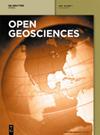GIS-based spatial modeling of landslide susceptibility using BWM-LSI: A case study – city of Smederevo (Serbia)
IF 1.3
4区 地球科学
Q3 GEOSCIENCES, MULTIDISCIPLINARY
引用次数: 0
Abstract
Landslides and slope processes constitute one of the most frequent natural hazards in valleys near major rivers and mountainous regions. The surface layer, characterized by its relatively loose composition, is prone to sliding due to a combination of distinct natural and human-related factors. Specific sections along the right bank of the Danube River in Smederevo city exhibit significant susceptibility to landslide activation, often leading to substantial material losses and posing a risk to the local population. The initial step in the provided research involves analyzing existing literature and mapping landslides within the study area. The initial analysis covers both natural conditions and anthropogenic activities. The second step includes establishing a geospatial database in the Geographic Information System and generating eight thematic maps. In the third step, different weight coefficients were assigned to the criteria, which facilitated the creation of the Landslide Susceptibility Index using the Best–Worst Method. Subsequently, in the fourth step, a composite map illustrating landslide susceptibility was produced. According to this research, about 4% of the territory of Smederevo, or 19.3 km利用 BWM-LSI 进行基于地理信息系统的滑坡易发性空间建模:案例研究 - 斯梅代雷沃市(塞尔维亚)
滑坡和斜坡过程是主要河流附近山谷和山区最常见的自然灾害之一。表层的特点是成分相对松散,在各种自然和人为因素的共同作用下,很容易发生滑坡。斯梅代雷沃市多瑙河右岸的某些地段极易发生山体滑坡,往往会造成巨大的物质损失,并给当地居民带来危险。研究的第一步是分析现有文献并绘制研究区域内的滑坡地图。初步分析包括自然条件和人为活动。第二步包括在地理信息系统中建立地理空间数据库,并生成八个专题地图。第三步,为标准分配不同的权重系数,这有助于使用最佳-最差法创建滑坡易感性指数。随后,在第四个步骤中,绘制了说明滑坡易发性的综合地图。根据这项研究,斯梅代雷沃约 4% 的领土,即 19.3 平方公里,极易或非常易发生山体滑坡。这些地方位于多瑙河右岸和拉利亚河周围。接收器工作特征曲线下的面积值表明预测能力非常高(约为 1),从而表明所使用方法的可靠性。对极易发生此类事件的地区进行可视化分析,有助于决策者采取更有效的环境保护措施,并对该地区的农业地块进行可持续管理。此外,这项研究首次将先进的遥感技术与跨学科调查结合起来,使人们对研究地区的滑坡活动有了更深入的了解,并取得了更全面的成果。
本文章由计算机程序翻译,如有差异,请以英文原文为准。
求助全文
约1分钟内获得全文
求助全文
来源期刊

Open Geosciences
GEOSCIENCES, MULTIDISCIPLINARY-
CiteScore
3.10
自引率
10.00%
发文量
63
审稿时长
15 weeks
期刊介绍:
Open Geosciences (formerly Central European Journal of Geosciences - CEJG) is an open access, peer-reviewed journal publishing original research results from all fields of Earth Sciences such as: Atmospheric Sciences, Geology, Geophysics, Geography, Oceanography and Hydrology, Glaciology, Speleology, Volcanology, Soil Science, Palaeoecology, Geotourism, Geoinformatics, Geostatistics.
 求助内容:
求助内容: 应助结果提醒方式:
应助结果提醒方式:


